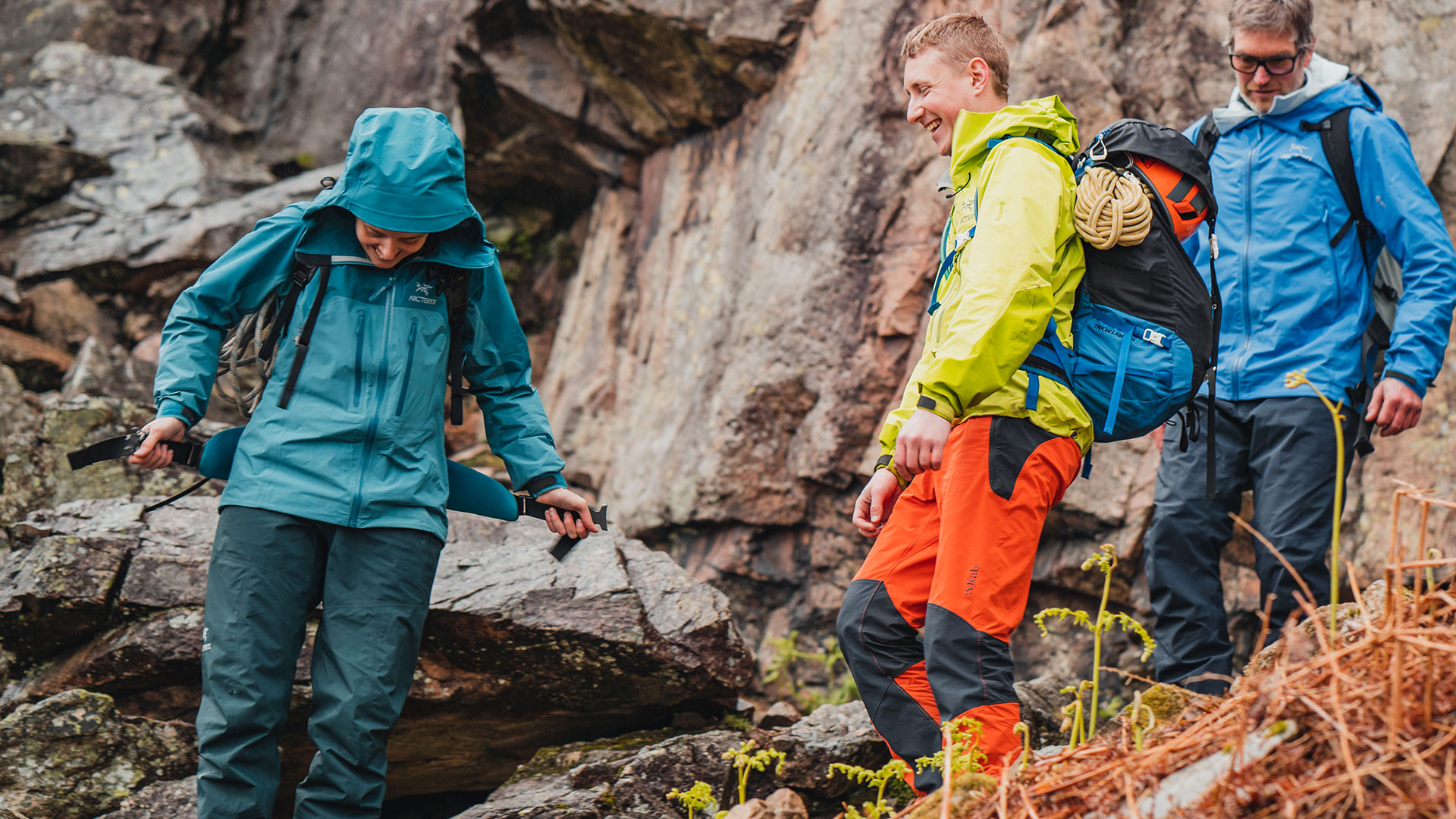What makes Arc'teryx waterproofs so good? We asked an insider
We get the low-down on the market-leading outdoors waterproof jackets


Arc'teryx is the brand behind what are generally considered some of the very best waterproof jackets on the market, but to the casual observer they can look pretty simple. I asked James Tomley, an Arc'teryx product expert who has been with the brand for seven years, to share exactly what's going on under the hood to make these waterproofs so effective.
We focused on two of the brand's key ranges: the Betas, which are built for general outdoors use, and are far-and-away Arc'teryx's bestselling jackets, as well as the Alphas, which are designed specifically for climbing. I got to try both of these lines out at the recent Arc'teryx Academy Climb Lake District event, where the weather was perfect for waterproof testing. Here are James' top 6 Arc'teryx design secrets.
1. Pocket positioning is key
The positioning of the pockets on the generalist Betas is different from what you'll find on the Alphas. Why? It's all to do with what you'll be wearing alongside them.
"Everything Alpha is directed towards someone who's operating on sort of rocky, icy terrain, usually on steep ground or vertical ground. The features are all geared towards the kind of protective equipment you'll need to incorporate," explains James. That means the pockets that are oriented vertically and high up on the chest, which means the wearer can easily dump stuff in there or grab things out, even then hanging off a wall, but also – crucially – they can still easily access the pockets when they're wearing a harness.
Because the Betas are designed to be all-rounders for any situation, the pocket positioning is lower down. "It's a bit more friendly, so that when you're walking to the shop when you're not mountaineering, you can put your hands in your pockets [without them being up under your chin]," he continues.

The Alpha AR (in Blue) has pockets positioned specifically for climbers
2. The product name suffixes have secret meanings
Most of Arc'teryx's jackets have an initialism at the end, which actually tells you something about that piece's special features. "Generally, the name tells you the silhouette, and then the abbreviation – LT, AR or whatever – tells you what the product is orientated towards," says James. Rather unhelpfully, there are also a few that don't have a suffix (like the Arc'teryx Beta, our #1 favourite waterproof at the moment). But we'll just ignore those for the purposes of this bit.
SV = Severe
Get all the latest news, reviews, deals and buying guides on gorgeous tech, home and active products from the T3 experts
"The first piece of clothing we ever designed was called the Alpha SV. So that was meant to be oriented towards really terrible weather. Really terrible places and terrible weather. So like, if you're on vertical ice in a snowstorm, then it's really great if you've got an Alpha SV on," elaborates James.
AR = All Round
"AR moves a little bit away from the extreme durability that we require from the SV," explains James. Rather than being winter-specific, it's good for use all year round. "The advantage of that is, by sacrificing a little bit of durability, you are reducing the package of weight that you're carrying. You're also reducing the pack size."
SL = Super Light
If you want something even lighter than an AR, you need to opt for an SL jacket. "SL is going one further on the lightweight criteria. So really gearing something up to be as minimal as possible," explains James. It's perfect for situations where the jacket is just there as a backup, and needs to be small and light enough that it's not going to be annoying if it's just sat in your bag all day. "[SLs are designed to] provide protection for someone who's not going to be wearing the product all day. It might be on and off and on and off. It's probably going to be carried quite a lot. Hence the product being light is one of its main criteria," explains James. For an example, head to our Arc'teryx Beta LT jacket review.
3. Fewer seams = better breathability
The jackets are designed so they use the minimum, optimum number of panels. That's important, because fewer panels means fewer seams. "Wherever you have stitching, you need seam tape, and wherever you apply seam tape, you've got to apply glue, and then you're reducing the overall breathable space on the product," explains James. "So less seam tape is a big thing."

The Alpha SL Anorak (far right), is a lightweight climbing waterproof that's perfect for stuffing in your bag, while the Beta (teal colour, second from left) is more of an all-rounder
4. Any seam is a potential point of weakness
Thought we were done talking about seams? You thought wrong. In fact, the seams are a really important thing in successful waterproof jacket design.
Arc'teryx's are made with an industry-leading 16 stitches per inch, using special sewing machines developed with Brother. More stitches mean a more precise seam, and potential to use a very low seam allowance. The excess fabric on the inside can be cut down really close to the hem, which makes it very easy to tape, and means you only need to use narrow, 6 or 8mm seam tape.
"It just means you get a really clean finish on the inside," says James. Why go to so much effort? Because any seam is a potential point of weakness. "They do look now like they've been laminated, but it's also a point that picks up a bit more abrasion, because it's less smooth than the nylon surface."
5. The fabric is a three-layer Gore-Tex sandwich
While the exact fabric components will vary from jacket to jacket, in general, the Alpha and Beta jackets all use three-layer textiles. Facing outwards is some kind of nylon, then there's a Gore-Tex membrane, then there's a backer on the inside.
"Those three layers are squashed together in a process called lamination, generally using heat and glue. That's what keeps them together," explains James. "With a three-layer textile you generally get something that's waterproof, windproof, breathable, very durable but also extremely packable and light."
6. The climbing jackets have a longer back
Another big difference between the climbing Alphas and generalist Betas is that the silhouette has been adjusted for different activities.
"Beta is more of a versatile silhouette," explains James. "So whereas Alpha's like, 'alpine climber', Beta is like 'outdoor person, who's maybe doing some climbing occasionally'. Maybe mountaineering, definitely hiking, definitely some snow sports." To make them cross functional, and to ensure they fit as many body types as possible, the Betas have a fairly boxy shape, although still with great articulation, so you can reach up without the jacket riding up
In contrast, the Alphas are shaped a bit like a shield. They also have a longer back than front, so you can sit on the tail of the coat, and if you're bending over forwards, you've still got coverage at the back, and you've not got rain sneaking in that way.

Ruth was T3's Outdoors and Wellness Editor from 2020 to 2022, covering hiking, camping and adventure sports kit, as well as mattresses, sleep accessories, yoga and general wellness. She's now a Homes Editor at sister site TechRadar, where she deals in all things air (vacuum cleaners, robovacs, fans and air purifiers), and hair (hair dryers, straighteners and stylers).